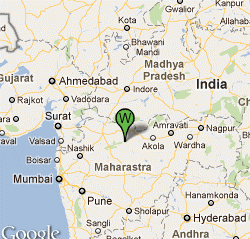Ajanta Caves

Ajanta Caves
Tour Place : Ajanta Caves
Country: India
Region: Aurangabad
Visitable: Yes
Ajanta Caves, rock-out cave monuments, are one of the most amazing archaeological sites of ancient Indian architectural heritage, which depicts the story of Buddhism throughout impressive figures .
|
 |
| Ajanta Caves - Aurangabad Top View , By S.Saravana Meikkannan |
Location :
Ajanta Caves is situated at a distance of 99km from Aurangabad in Maharashtra. They are cave shrines cut out of rock, by hand, and houses one of the most amazing archaeological sites of ancient Indian architectural heritage in a panoramic gorge, in the form of a gigantic horseshoe.
 |
| Ajanta Caves - Aurangabad Main , By S.Saravana Meikkannan |
Structure :
Built by cutting the huge granite hillside and in according to the historical evidences, caves were built by Buddhist monks, who lived here for a longer period of time. The 29 caves at Ajanta are Buddhists and dates back between the 2nd century BC and 6th century AD.
History Of Ajanta Caves :
 |
| Ajanta Caves - Aurangabad - Buddha Temple , By S.Saravana Meikkannan |
Ajanta Caves remained shrouded in obscurity for a long period until John Smith, a British Army Officer, accidentally stumbled upon them while on a hunting expedition around 1845 with a group of British officers in the Deccan Plateau.
Soon they discovered several caves behind the bushes and informed to the government. The caves provide the finest example from the Chalukya, Kalachuri and Rashtrakuta periods.
Astonishingly carved into hillside rock in the middle of nowhere, the Ajanta Caves are a protected monument under the Archaeological Survey of India and has been included as a World Heritage Site. The “View Point” from where John Smith first glimpsed the caves, provides a magnificent sight of the U-shaped gorge and its scenic surroundings. Cascading down the cliff is a spectacular waterfall, which at the bottom feeds a natural pool called the Saptakunda.
Buddha – Ajanta Caves
 |
| Ajanta Caves - Aurangabad - Buddha Temple , By S.Saravana Meikkannan |
Ajanta caves depict the story of Buddhism, spanning a period from 200BC to 650AD. The monks using rudimentary hand tools like hammer and chisel but with a deep faith inspiring them, they carved out the impressive figures adorning the walls of these structures.
The caves comprise Chaitya Halls, or shrines, dedicated to Lord Buddha that are large, rectangular chambers separated by rows of pillar and the Viharas, or monasteries, used by Buddhist monks for meditation and where they lived and thought and carried out ritual performances. Five caves are Buddhist cathedrals and the rest are monasteries.
Amazing Paintings :
 |
| Ajanta Caves - Aurangabad - Amazing paintings , By S.Saravana Meikkannan |
The caves house some of the most beautiful and well preserved paintings, including two great Boddhisattvas: Padmapani and Avalokiteshwara. The Boddhisatvas in the Ajanta paintings are celestial beings, often personifications of the virtues of Buddha, who visit the world of men.
 |
| Ajanta Caves - Aurangabad - Amazing paintings , By S.Saravana Meikkannan |
The paintings in their range of time are a panorama of life in ancient India and could well study for a description of the culture of those times. Many of the caves house panels depicting stories from the Jatakas, a rich mine of tales of several incarnations of the Buddha, as well as images of nymphs and princesses are elaborately portrayed. The flying apsara and the image of Buddha in the cave number 17 are simply amazing.
Phases Of Ajanta Caves :
 |
| Ajanta Caves - Aurangabad - Amazing paintings , By S.Saravana Meikkannan |
The Earlier Hinayana phase 1 :
In which the Buddha was worshipped only in the form of certain symbols.
The Later Mahayana phase 2 :
In which the Buddha was worshipped in the physical form.
More Details About Ajanta caves :
 |
| Ajanta Caves - Aurangabad , By S.Saravana Meikkannan |
Ajanta has two kinds of caves,The finished caves with 27 and depict different forms of Buddha; and the unfinished caves with some of them are accessible.
Originally the itinerant monks sought shelter in natural grottos during monsoons and began decorating them with religious motifs to help pass the rainy season. They used earlier wooden structures as models for their work.
As the grottos were developed and expanded, they became permanent monasteries, housing perhaps 200 residents.
 |
| Ajanta Caves - Aurangabad , By S.Saravana Meikkannan |
Although the responsible for Ajanta did not just hack holes in the cliff, they carefully excavated, carving stairs, benches, screens, columns, sculptures and other furnishings and decorations as they went, so that these elements remained attached to the resulting floors, ceilings and walls.
They also painted patterns and pictures, employing pigments derived from natural water soluble substances. In addition they worked only by the light of oil lamps with a little sunshine penetrating cave entrances.
Conclusion :
 |
| Ajanta Caves - Aurangabad , By S.Saravana Meikkannan |
The abandonment of these masterpieces around seventh century is a mystery. Perhaps the Buddhist suffered religious persecution, or maybe the isolation of the caves made it difficult for the monks to collect sufficient alms for survival. Some ones suggest that Ajanta colony was relocated to Ellora, another series of handcrafted caves chronologically begins where the Ajanta caves end.
Express Your Thinking about this Wonder , Plz mention it through Comments…



Leave a comment